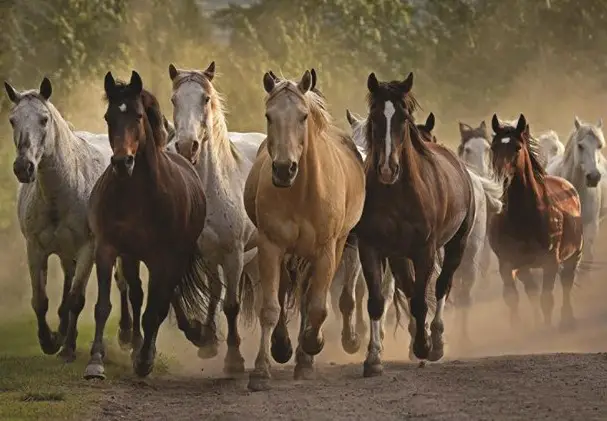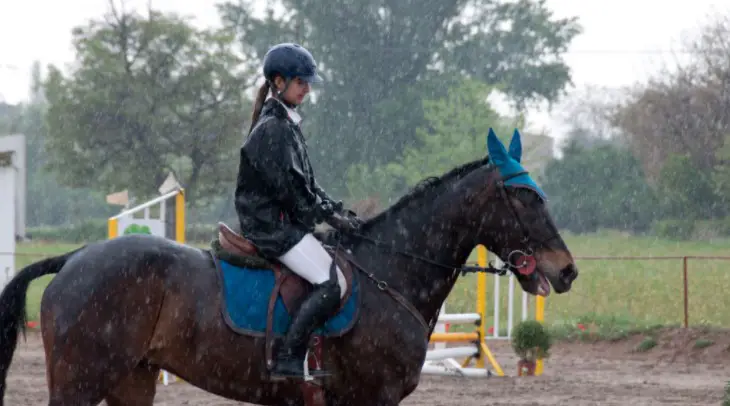There is no short answer to this question because horses differ. No two horses walk or run precisely the same way, so how far one horse can travel may not be the same as the next horse.
A few factors affect the speed of a horse. First, a horse may have a slow gait or a fast trot when walking. A horse may have an even quicker trot, affecting the general outcome of its speed. Second, the age and breed of a horse determine its speed. Some horse breeds are naturally fast and may outrun younger horses despite their age. Plus, there is the terrain and weather to consider when determining how fast a horse can travel in just one day.
An average, well-fed, healthy horse will run about 20 miles or 32 km in a day. Some may run a little further – between 25 and 35 miles or 40 to 56.5 km – as long as they rest, have enough water, and eat well.
Factors That Affect How Far a Horse Can Travel
Before running with this information, it is crucial to keep some factors in mind. They affect how well your horse will run, even when healthy and well-fed. We are going to discuss these factors in detail.

Pace
The walking speed of an average horse is about four miles per hour. At a trot, the horse may get up to ten to 12 miles an hour, and at galloping speed, it may get up to 30 miles an hour. It all depends on the breed and the terrain you take. Additionally, your skills as a rider and the weather during the ride can also affect it.
A trail horse in average shape can travel up to 50 miles a day while galloping. A more fit and competitive horse can do up to 100 miles a day. At a slower pace, both categories of horses can go further. But the horse must have a couple of days to rest to regain its strength. Consecutive days of travel will wear it out.
Gait
The distance a horse can cover, whether in a day or an hour, also depends on its gait. Some horses have a better gait than others. It makes them more comfortable to ride on and helps them travel farther without burning so much energy.
Horses have two types of gait: ambling and natural. When a horse learns to combine learned movements and natural ones, it’s called an ambling gait. It includes galloping and cantering. Galloping is a combination of ambling and walking naturally. At a gallop, a horse moves faster. However, a canter is slower, like a gait done in three beats. A horse cannot cover a lot of distance when cantering.
A horse has a natural gait when it walks, trots, or runs. A natural walk of a horse is a gait in four beats, and a horse can go up to four miles an hour while walking. A natural trot is a gait of two beats, and a horse can cover up to eight miles an hour while trotting.
Terrain
If you want a horse to travel far, you must choose a smooth terrain. Much like a person walking on rocky or unfamiliar terrain, a horse will slow down if it comes to a rough place. It cannot maintain the same pace as walking, trotting, or galloping on smooth and familiar terrain. This factor affects how far it can go in an entire day.
In the same vein, if you take a horse up or down a hilly place, its heartbeat will increase and slow it down. Also, its legs will hurt if you travel that path for a prolonged period. It is the same as when you run up and down the stairs. No matter how fit you are, you will wear out if you do it for a while.
It would be best if you considered the terrain. Overall, it reduces its speed and impacts the distance covered in a day. Additionally, rough terrain may negatively impact the horse’s hooves, as stones and other sharp objects destroy the shoes.
Aside from the feet, the joints can also suffer as the horse tries to navigate the uneven ground without hurting itself. So, if you will travel a long distance on a horse, choose a smooth terrain, preferably a grassy one.
General Fitness and Health
Horses are naturally energetic animals that need regular exercise. Therefore, if you want to cover some distance, you have to keep your horse regularly trained to keep them in shape. But if a horse is not healthy or is getting along in years, it may not perform so well, no matter how hard you train it.
Older horses tend to have health issues such as arthritis. As a result, they cannot cover much distance or even spend a lot of time standing without hurting. The same applies to a horse suffering from an injury. Therefore, if your horse is not so young or has a recent injury, keep the pace slow and the distance short.
Bring sufficient water and food for the horse, and stop as often as possible to rest the animal. It is up to you to know when to ease up. Constantly check on your horse so it does not buckle under the strain of continuing when in pain. Do note, though, that the stops will significantly impact how far the horse travels.
Using a younger and better-trained horse will be much easier and more rewarding. Horses also tend to move as a group. So, if you are traveling as a group, the horse may not want to stop if others don’t.
Riding Equipment
Use proper riding equipment, such as a bridle and saddle, if you will be riding a horse for a day. The correct equipment makes the journey easier and smoother for you and the horse.

If you use the wrong type, you may hurt the horse and make yourself uncomfortable. Consequently, the horse will go slower, and the journey will be longer. Worse still, if the horse loses a shoe or injures itself due to the ill-fitting gear, you will have to end the trip.
Weather
You know how difficult it is to make a journey in bad weather, even if you are in a car. The same applies to riding a horse in hot or cold weather. Horses tend to fare better in temperatures between 70°F and 90°F, or 21°C to 32°C.
Horses don’t like getting wet. These animals don’t particularly like the cold, and a rainy day does not work either because of the damp ground. If you push through and travel in the rain, expect the horse to have breaks every two to five miles. The horse may travel up to ten miles before seeking shelter and warmth in freezing weather.

Apart from the issues of comfort, extreme weather conditions may cause your horse to become ill or sustain injuries. The horse may suffer from dehydration if you travel in hot weather. It helps to check the weather forecast for the day before setting out on a horseback trip. Your horse won’t travel far or do well in bad weather, and neither will you.
Strength and Skills
Your strength to endure a day’s journey on horseback can also affect how far a horse goes. You may be forced to stop too often and make the trip longer than usual. If you don’t have adequate riding skills, you may find yourself stuck far from home, with no leftover strength to continue.
Therefore, try to go on test rides, short distances that don’t wear you out. That way, you and your horse are in sync. You can also improve your riding skills, and you help your horse travel farther in a day’s journey.
Conclusion
A horse can travel as far as 35 miles in a day if all the necessary conditions are in order. Ensure you feed it well and keep it hydrated. Additionally, have a vet check them before you take them on a whole day’s journey.
